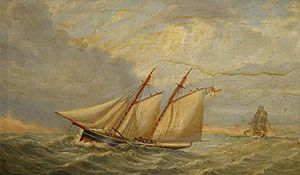HMS Sandfly (1872) facts for kids
 |
|
Quick facts for kids History |
|
|---|---|
| Name | HMS Sandfly |
| Builder | John Cuthbert, Millers Point, New South Wales |
| Launched | 5 December 1872 |
| Fate | Sold in 1883 to Samoa |
| General characteristics | |
| Type | Beagle-class schooner |
| Tons burthen | 120 bm |
| Length | 77 ft 0 in (23.5 m) |
| Beam | 18 ft 6 in (5.6 m) |
| Depth of hold | 8 ft 6 in (2.59 m) |
| Sail plan | Schooner |
| Complement | 27 |
| Armament | 1 × 12-pounder gun |
HMS Sandfly was a small sailing ship called a schooner. It belonged to the Royal Navy, which is the United Kingdom's navy. The ship was built in Australia by John Cuthbert and launched on December 5, 1872.
The Sandfly started its work in 1873 from Sydney, Australia. Its main job was to stop "blackbirding" in the South Pacific. Blackbirding was a terrible practice where people were tricked or forced from their homes to work, almost like slavery. The ship was taken out of service in 1883 and sold to Samoa.
Adventures and Voyages
The Sandfly was based at the Australia Station in Sydney until June 1873. Its first trip was a short tour around the South Pacific islands. In October, under Lieutenant W H Nowell, the ship stopped a brig called Aurora. The Aurora was breaking a law that banned blackbirding.
In 1874, the Sandfly went on a second voyage to New Guinea. It was helping with mapping the area. During this trip, a big storm hit the ship and damaged its steering part, called the rudder. Another ship, HMS Basilisk, helped the Sandfly get back to Sydney for repairs.
Later, the Sandfly sailed to the Santa Cruz Islands. On September 17, a large group of islanders in canoes attacked the ship. After a short but intense fight, a breeze helped the Sandfly escape. Islanders at Santa Cruz had also attacked another ship, the Lapwing, a few months before.
The Sandfly Incident
In 1880, the Sandfly was given a new job: to map the waters around the Solomon Islands and New Guinea. This work is called a hydrographic survey. Lieutenant James Bower, who was 27 years old, was in charge.
On October 13, 1880, the Sandfly dropped anchor near Guadalcanal. Lieutenant Bower took a small boat, called a whaleboat, with five sailors to the Nggela Islands. They planned to map the east coast of Nggela Pile. They set up camp on a small island named Mandoliana.
A group of four islanders from Gaeta, led by Vuria, attacked Bower and his team. Vuria was the son of a local leader named Kalekona. Four sailors were killed right away. Lieutenant Bower tried to hide but was found and also killed. One sailor managed to escape. He swam about 16 kilometers to Honggo on Nggela Pile, where another islander rescued him.
When Bower's group did not return by October 20, the Sandfly started searching. On October 22, they found the surviving sailor. After hearing about the attack, the Sandfly sailed to Rita Bay, near Mandoliana Island. The crew burned some canoes on the beach as a response. As they were leaving, islanders fired at the sailors, killing one and wounding another. The Sandfly then returned to Sydney to report what happened.
Aftermath of the Incident
The British sent HMS Emerald to the Nggela Islands in December. Its captain, William Henry Maxwell, could not find the attackers. So, the crew of the Emerald burned many islanders' houses, cut down fruit trees, and destroyed canoes. This was done as a punishment for the attack and other incidents.
The British government was not happy with this result. They sent Commander James Bruce on HMS Cormorant, along with HMS Alert. Another ship, HMS Renard, joined them in the Solomon Islands. Commander Bruce blocked the islands and said he would declare war unless the attackers were handed over within 14 days.
Bishop John Selwyn, who was visiting the islands, stepped in. He convinced Kalekona, Vuria's father, to give up the people involved. The four islanders who were with Vuria were punished. However, Vuria managed to escape and hide. The British tried to find Vuria for several years after his escape, but they were not successful.
See also
- List of massacres in the Solomon Islands

